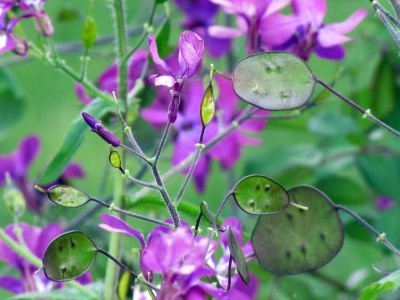Money Plant Growing Info
Also known as Honesty, of the genus Lunaria, silver dollar plants are named for their fruit, with pods dry to flat silverish discs about the size of — you guessed it — silver dollars. They hail from Europe and were one of the first flowers grown in the dooryard gardens of the New World for their pods and edible roots. They are members of the family Brassicaceae or mustard family, which is evident in their foliage: fast-growing, single stems that can reach about 2 feet (61 cm.) high with broad oval leaves that are coarsely toothed. There is nothing mustard-like about the flowers, however. They are delicate, four-petaled, pink to purple blossoms grown in racemes or clusters atop the long stems and bloom in early to midsummer. The seed pods produced by these dainty flowers are what make caring for a money plant worthwhile. By late summer, the large flat seed pods have dried to silvery discs that show off the seeds inside. Maybe those gardeners who consider the flower to be a pest have a valid argument. Once you learn how to grow money plants, they tend to become permanent additions to the landscape and pop up anywhere except where you wanted them. Even some experts refer to them in their money plant growing info as weeds. Shame on them! They certainly aren’t suitable for more formal gardens, but they can be a delight elsewhere. Still, there are some very good reasons for caring for money plants in your garden.
Why Grow Lunaria Silver Dollar
Nothing interests kids in flower gardening like learning about how to grow money plants. The seeds sprout easily. The plants grow quickly. The flowers are delightful and no child can resist those fascinating seed pods. Money plant care instructions are easy to follow and plants are easy to ignore! They’ll happily grow in a patch of weeds. For many of us with more informal style gardens, surprises are always welcome and considered part of the fun. Nothing is as surprising as the money plant. Growing info usually points this out as a negative because the silver dollar’s papery pods are carried like kites on the wind and germinate where they fall. While lunarias are biennials, growing one year and flowering the next, they are so prolific they are often mistaken for perennials and considered invasive. What the money plant growing info usually fails to mention is they are so much easier to weed out than most other garden annoyances. The dried stalks of the Lunaria silver dollar plant makes excellent additions to dried flower arrangements created from your landscape either in conjunction with other plants, such as grasses, or alone clustered in a vase.
Money Plant Care Instructions – Tips on How to Grow Money Plants
Money plant care instructions are easy and straightforward. Seeds can be directly sown at any time from spring to fall but are easiest to plant in the spring. Sprinkle them on the earth and cover with a light coating of soil and water well. They prefer a sunny location, but will grow well in semi-shade and have no particular preference for soil type, which is why they are so likely to turn up growing among your more fussy garden plants. Anywhere is home to a money plant! Care instructions usually include at least one dose of general use fertilizer per year, but again, they’ll accept whatever you offer surrounding plants. Once it germinates, caring for a money plant is just that simple. If the weather becomes too dry, they appreciate a little water, but not too much. About the only thing a Lunaria silver dollar objects to is soggy feet. Give them a try and form your own opinion about the value of learning how to grow money plants in your garden.
